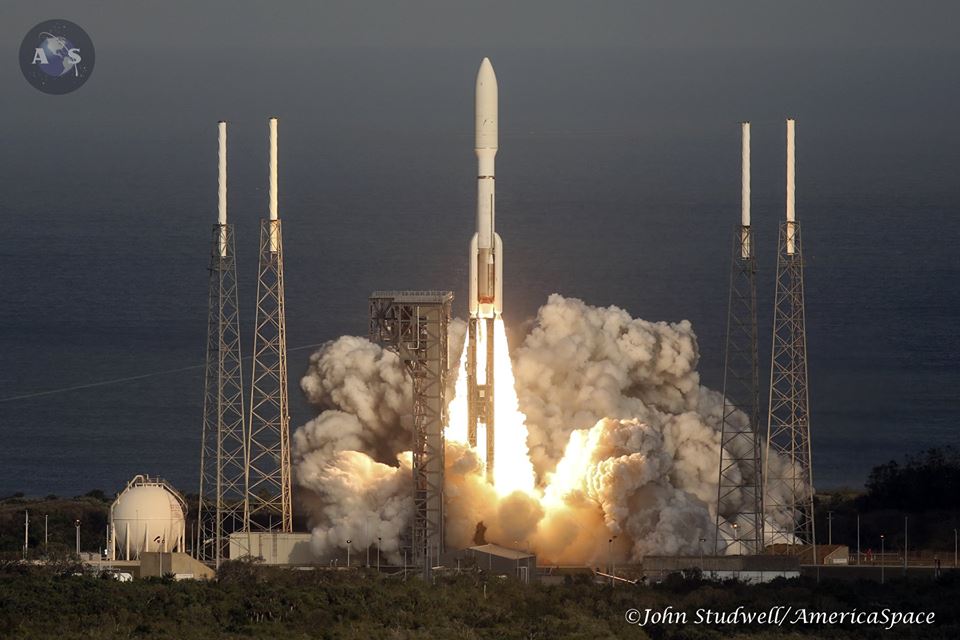
The nation’s brand new game-changing GOES-17 meteorological satellite (formerly GOES-S), launched in early March 2018, has hit a snag in its on-orbit commissioning. The problem is a performance issue recently discovered with the cooling system of the satellite’s Advanced Baseline Imager (ABI) instrument, which is integral for the ABI to function properly.
GOES-17 is supposed to provide advanced imaging in support of better weather forecasts, as well as real-time lightning mapping and enhanced solar monitoring. The three-axis-stabilized spacecraft weighs approximately 6,170 pounds (2,800 kg) and represents a quantum leap in capability above its predecessors, boasting three times more spectral information, four times higher spatial resolution, five times faster coverage, and significantly enhanced functionality in providing advance warnings of storms, tornadoes, hurricanes, and solar-induced events, ranging from geomagnetic storms to Coronal Mass Ejections (CMEs).

The new satellite was launched to cover the western United States, together with Alaska and Hawaii, collecting imagery every 30 seconds and providing detailed atmospheric measurements to monitor weather patterns and severe storms. It will also track lightning, wildfires, dense fog and other hazards which frequently impact the western seaboard.
Its “Earth-facing” ABI was developed for visible and infrared observations of Earth’s weather and climate, enabling storms to be tracked in their early stages, along with a Geostationary Lightning Mapper (GLM) for continuous, day-and-night measurements of intra-cloud lightning associated with severe storms. It is hoped that their combined data will improve warning times ahead of tornadoes, as well as aiding the development of climatological models, thunderstorm warnings, and improving aviation weather services.
But not if the ABI can’t stay cool in order to function properly. The ABI needs a freezing -350°F to conduct its infrared science, the big “game changer” GOES-17 is expected to bring to meteorology and Earth Science. But the cooling system is currently only keeping the ABI at its optimum operational temperature for 12 hours a day.
Below is NOAA’s full statement:
“A team of experts from NOAA, NASA, the ABI contractor team and industry are investigating the issue and pursuing multiple courses of possible corrective actions. The issue affects the infrared and near-infrared channels on the instrument. The visible channels of the ABI are not impacted.
NOAA’s operational geostationary constellation — GOES-16, operating as GOES-East, GOES-15, operating as GOES-West and GOES-14, operating as the on-orbit spare — is healthy and monitoring weather across the nation each day, so there is no immediate impact from this performance issue.
If efforts to restore the cooling system are unsuccessful, alternative concepts and modes will be considered to maximize the operational utility of the ABI for NOAA’s National Weather Service and other customers. An update will be provided as new information becomes available.”
The Lockheed Martin-built GOES-17 is the second member of the fourth generation of spacecraft which have revolutionized our understanding of Earth since the 1970s. Operated by the United States’ National Environmental Satellite, Data and Information Service (NESDIS), the multi-spacecraft GOES network is responsible for weather forecasting, storm tracking and meteorological research from geostationary orbit.

GOES-17 was designed to support a decade of operational service.
Whatever the case, losing the infrared capability of the ABI wouldn’t spell disaster for meteorology, however it would be quite a blow to advancing science in meteorology and quicker, more accurate forecasting of various weather phenomenon which cause billions of dollars in damage each year, in addition to loss of life.
– We will update as new information is released.
FOLLOW AmericaSpace on Facebook!
.





